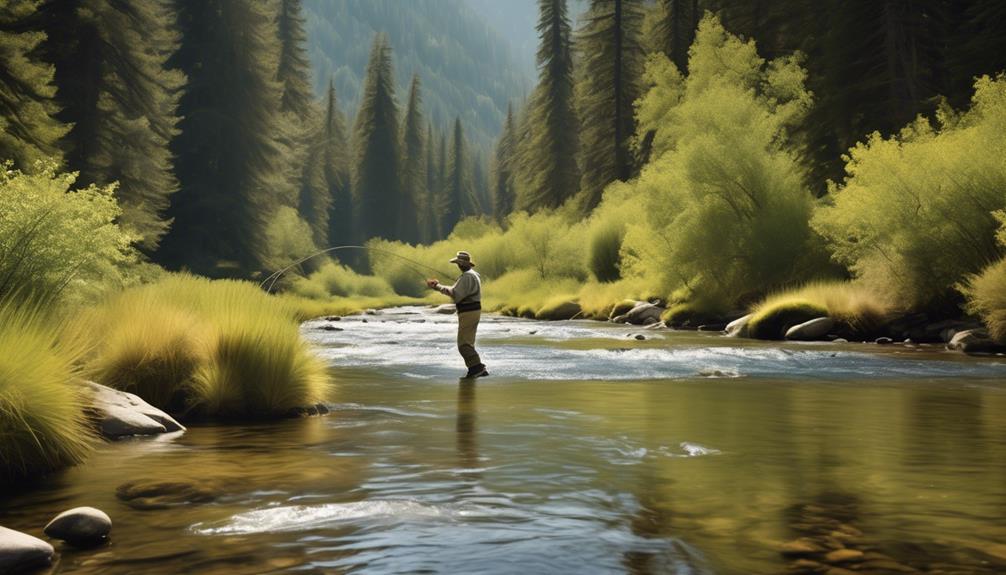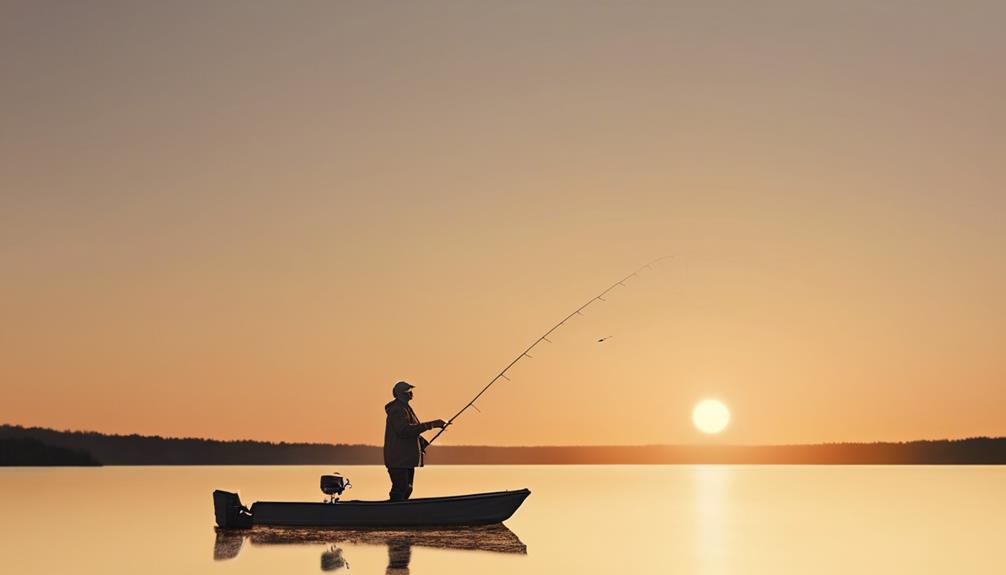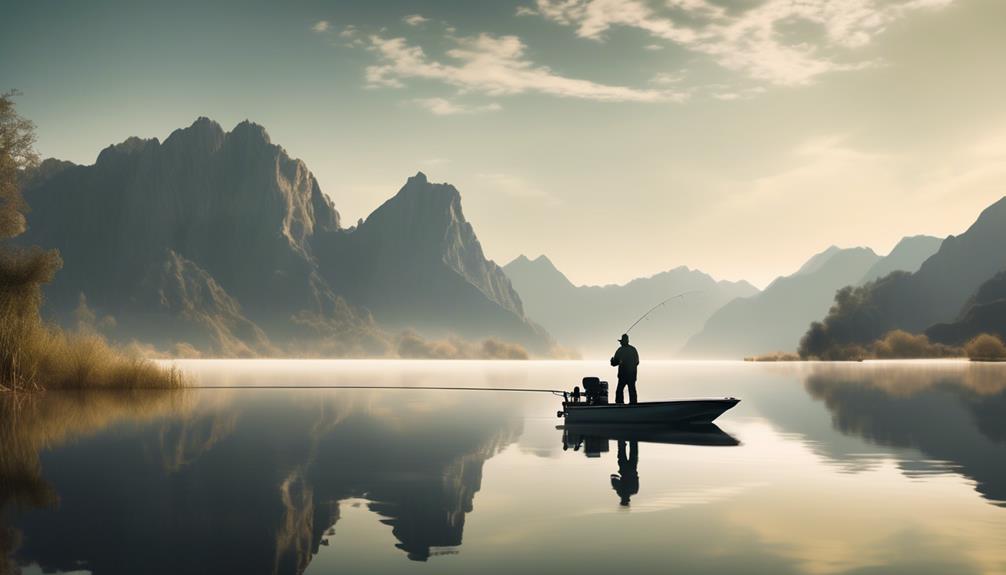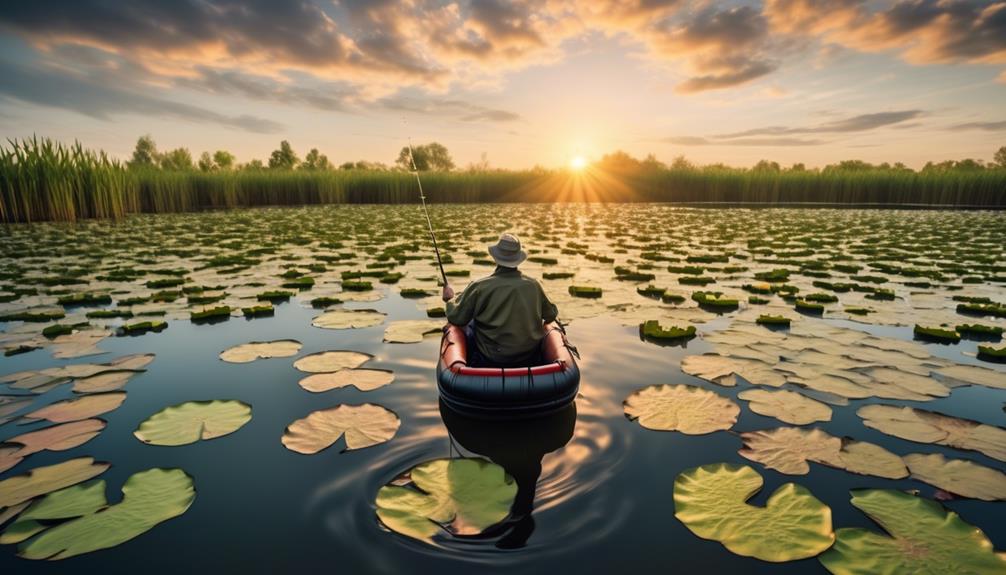When it comes to fly fishing for trout, it's like unlocking a treasure trove of techniques, each one a potential key to unlocking the secrets of a river's inhabitants.
Imagine yourself as a detective, carefully selecting the best tool for the job, each method offering a unique approach to luring in those elusive trout.
But why are these fly fishing techniques deemed the best for trout? What is it about each method that makes it stand out among the others, and how can you use this knowledge to elevate your angling game?
Dry Fly Fishing
When dry fly fishing for trout, position yourself upstream of the target area and cast your fly gently onto the water's surface to mimic natural insect behavior. This technique is effective because it presents the fly naturally to the trout, mimicking the behavior of insects that land on the water. As the fly drifts downstream, keep an eye on it, as trout often strike quickly after the fly lands. It's important to stay focused and ready to set the hook.
When selecting dry flies for trout, consider the types of insects that are active in the area you're fishing. Matching the hatch—using a fly that closely resembles the insects the trout are feeding on—can significantly improve your chances of success. Additionally, pay attention to the size and color of the flies, as these factors can also influence the trout's response.
When casting your dry fly, accuracy is crucial. Try to land your fly gently on the water, avoiding splashes that could startle the trout. Cast upstream and allow the fly to drift naturally downstream, riding the current. Be patient and observant, as trout can be selective and may only rise for specific insects or presentations.
As you practice dry fly fishing, pay attention to the behavior of the trout. Notice how they react to different fly presentations and learn from each experience. With time and patience, dry fly fishing for trout can become a rewarding and engaging pursuit.
Nymphing Techniques
If you've had success with dry fly fishing for trout, you'll find that nymphing techniques offer a different but equally effective approach to enticing these elusive fish. Nymphing involves fishing with imitations of aquatic insect larvae or nymphs, which are a primary food source for trout.
Here are some reasons why nymphing techniques are so effective:
- Natural Drift: Nymphs are aquatic insects in their early life stages, and they spend most of their time drifting in the water. By using nymphing techniques, you can mimic this natural drift, making your fly look irresistibly realistic to trout.
- *Tip*: To achieve a natural drift, mend your line as the nymph drifts downstream, keeping it from dragging and maintaining a lifelike presentation.
- Year-Round Effectiveness: Unlike dry flies, which are most effective during hatches, nymphing can be productive year-round. Since nymphs are always present in the water, trout are conditioned to feed on them consistently.
- *Tip*: Vary your nymphing depth based on water conditions and trout behavior. Use a strike indicator to detect subtle takes when fishing deeper water.
Streamer Fishing
Streamer fishing offers an exciting and dynamic approach to targeting trout, using imitation baitfish patterns to entice aggressive strikes. When employing streamer fishing techniques, you'll cast these larger, more substantial flies across the water and retrieve them in a manner that mimics the movement of a fleeing baitfish. This method appeals to the predatory nature of trout, prompting them to strike out of aggression or the instinct to feed on smaller fish.
One of the primary advantages of streamer fishing is its effectiveness in enticing larger trout. By imitating the appearance and behavior of larger prey, streamers appeal to the territorial and predatory instincts of big trout, often resulting in more substantial catches. This technique is particularly effective in deeper or faster-moving waters, where larger trout are known to lurk and hunt for prey.
Moreover, streamer fishing allows for versatility and creativity in presentation. Anglers can vary the speed and depth of their retrieves, as well as experiment with different patterns and colors to determine what elicits the most aggressive response from the trout. This flexibility makes streamer fishing an engaging and interactive method, as you adjust your tactics based on the trout's behavior and the specific conditions of the water.
Euro Nymphing
Euro Nymphing, also known as Czech nymphing, is a highly effective fly fishing technique for targeting trout in rivers and streams. This method involves using heavily weighted nymphs without the use of traditional fly line and with minimal fly line on the water's surface.
Here's why Euro Nymphing is a great technique for catching trout:
- Increased Sensitivity: By eliminating the traditional fly line, you can directly connect your leader to the rod tip, allowing you to feel even the slightest bite. This increased sensitivity means you can detect more subtle strikes, resulting in more hooked fish.
- Effective in Various Conditions: Euro Nymphing is particularly effective in fast-flowing water, deep runs, and pocket water where trout are commonly found. The ability to get your flies down to the feeding zone quickly and keep them there, even in swift currents, makes Euro Nymphing a versatile and productive technique.
Tenkara Fly Fishing
Tenkara fly fishing is a traditional Japanese method that utilizes a long, telescoping rod and a simple line and fly setup. This technique is gaining popularity among anglers due to its effectiveness in catching trout in small streams and tight spaces. The long rod, typically around 11 to 14 feet in length, allows for precise casting and delicate presentations, making it ideal for targeting trout in clear, shallow water.
One of the key advantages of tenkara fly fishing is its simplicity. With no reel involved, the setup consists of only a rod, a line, and a fly. This simplicity not only makes the gear lightweight and easy to transport but also streamlines the casting process, allowing anglers to focus on the presentation and drift of the fly. The lack of a reel also means that there are fewer moving parts, reducing the risk of mechanical malfunctions while out on the water.
Additionally, tenkara fly fishing emphasizes the use of kebari patterns, which are traditional Japanese flies. These flies are often tied with soft hackle and sparse materials, giving them a lifelike appearance in the water. The subtle movements of these kebari patterns can be highly enticing to trout, especially in small streams where a natural presentation is crucial for success.
Czech Nymphing
A highly effective nymphing technique for trout fishing, Czech Nymphing involves using weighted flies to target fish in fast-flowing waters. This method originated in the rivers of the Czech Republic and has since gained popularity worldwide due to its effectiveness, especially in swift currents where traditional nymphing techniques may struggle to reach the desired depth.
When Czech Nymphing, keep the following in mind:
- Equipment: Use a long, light, and sensitive rod to detect subtle strikes in fast water. Pair this with a specialized Czech Nymphing line that's thin and heavy to aid in casting and getting the flies down quickly.
- Flies: Tie or purchase a selection of heavy, slim-profile flies that imitate the aquatic insects found in the waters you're fishing. These flies should sink quickly and maintain a natural drift close to the riverbed where trout are likely to feed.
Czech Nymphing is particularly effective in pocket water, riffles, and runs where trout hold in fast currents. This technique allows you to get your flies deep into the feeding zone quickly and keep them there for an extended period, increasing your chances of enticing a strike. By understanding the principles of Czech Nymphing and practicing the necessary techniques, you can significantly improve your success in catching trout in fast-flowing rivers.
Indicator Techniques

If you're looking to expand your trout fishing repertoire beyond Czech Nymphing, consider incorporating indicator techniques to enhance your success in diverse river conditions. Using indicators, also known as 'bobbers,' can significantly improve your ability to detect subtle strikes from trout, especially in areas with complex currents or when fishing at greater depths. By suspending nymphs or other subsurface flies at a specific depth, indicators allow you to maintain precise control over your presentation and detect even the most delicate takes.
One of the primary advantages of indicator techniques is their versatility. Whether you're fishing in fast-flowing freestone streams, slow-moving spring creeks, or deep pools, indicators can be adjusted to suit different water speeds and depths, making them an ideal choice for various river conditions. Additionally, indicators enable you to fish multiple nymphs simultaneously, increasing your chances of enticing trout to strike.
When using indicator techniques, it's essential to focus on achieving a natural drift. Proper mending and positioning of the indicator are crucial to presenting your flies in a lifelike manner, mimicking the natural movement of aquatic insects. By mastering the art of controlling your drift, you'll be able to entice more trout to take your flies.
Wet Fly Swing
To enhance your trout fishing skills, consider incorporating the wet fly swing technique to effectively present your flies in moving water. This classic and versatile method is particularly effective in rivers and streams with a moderate current.
Here's why wet fly swing is an essential technique for targeting trout:
- Engaging Presentation: The wet fly swing technique involves casting the fly downstream and letting it drift across the current before using the rod to create a swing that brings the fly across the water column. This mimics the natural movement of emerging insects or small baitfish, making it an enticing presentation for trout.
- *Visual Appeal*: As the fly swings across the water, it creates a visually appealing movement that can trigger aggressive strikes from trout, especially when they're actively feeding near the surface.
- *Covering Water*: Unlike other techniques that focus on specific spots, the wet fly swing allows you to cover a larger area of water, increasing the chances of enticing trout that are holding in different parts of the river.
Frequently Asked Questions
What Are the Best Types of Flies to Use for Each Technique?
For each technique, match your flies to the trout's prey. Use dry flies like mayflies or caddis for surface fishing. Nymphs imitate aquatic insects and are great for subsurface fishing. Streamers mimic small fish and work well for aggressive trout.
How Should I Approach a River or Stream When Using These Techniques?
Approach a river or stream with caution, keeping low to avoid spooking trout. Position yourself upstream and cast your fly downstream, allowing it to drift naturally. Be patient and observant for the best results.
Are There Specific Times of Day or Weather Conditions That Work Best for Each Technique?
You'll find that each fly fishing technique can be effective at different times of day and in various weather conditions. For example, dry fly fishing is best during hatches or when fish are rising.
What Are Some Common Mistakes to Avoid When Using These Techniques?
When using these techniques, avoid using the wrong fly for the conditions, failing to match the hatch, and neglecting to properly present the fly. Keeping a sharp eye and adjusting to the trout's behavior is key.
Can These Techniques Be Used in Both Still Water and Moving Water Environments?
Yes, these techniques can be used in both still water and moving water environments. In still water, you'll need to adjust your presentation, while in moving water, you'll need to focus on line control.
Conclusion
So, now you know why these fly fishing techniques are best for trout. Whether you're casting dry flies, nymphing, or using streamers, each technique has its own advantages and can help you catch more trout.
Keep experimenting with different techniques and find what works best for you in different fishing conditions.
Happy fishing!



